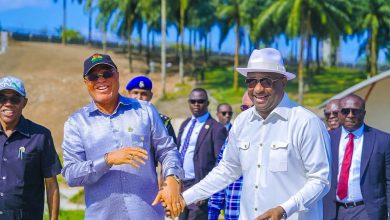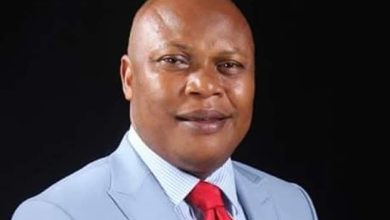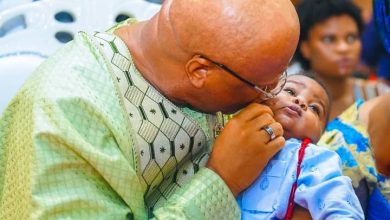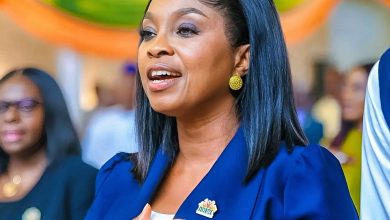
“I repeat that we all stand before history. I and my colleagues are not the only one on trial. Shell is here on trial…Its day will surely come and the lessons learnt here may prove useful to it; for there is no doubt in my mind that the ecological war the company has waged in the Niger Delta will be called to question sooner or later and the crimes of that war be duly punished…On trial too is the Nigerian Nation” – Ken Saro-Wiwa’s prognoses on the travails of the Ogoni 9, September 1, 1995.
THEY DIED FOR THE SAKE OF THE NIGER DELTA. These sound like epigrammatic immortal words on the marble of their invisible tombs.
Just two months to their end, Ken Saro-Wiwa made the superscripted statement as part of his swansong to series of events that grievously culminated in his death and that of the other eight agitators and advocators, popularly known now in history as OGONI 9. On November 10, 1995, the Ogono 9 were made to walked through the guillotine, with late Gen. Sanni Abacha as the ultimate commando who gave the nod for the execution.
Because of the intensity and volume of appeals from prominent leaders and human rights groups across the world, at a point not a few thought in their contemplative foreboding that Gen. Abacha was going to enforce presidential clemency or parole on the hapless but daring agitators. But the junta was a psychopathic despot.
Ken and fellow activists were first remanded in the Port Harcourt Prisons for just two hours, before being executed in the morning of November 10, 1995 and buried in shallow graves and allegedly soaked with acid for hastened decomposition.
By today, there is intense resonationon the memories and underground historical vibrations on that unforgettable gloomy day and exactly 24 years since what observers called avoidable and masterminded pogrom took place because wilders of power wanted it exactly that way to gratify their sadistic wishes. 10th November of every year therefore rakes up the past and brings back to the conscious mind the sequence of events and that last strike in the guillotine that put an end to the widely celebrated but helpless OGONI 9.
That successive administrations, like the present government, tends to talk with complacent pride and sanctimonious claim of superior national interest in the Niger Delta can only sound strange to casual students of history. Otherwise, apart from a pioneer like Isaac Adaka Boro, the Ogoni 9 deservedly and posthumously owns the copyright to all prototypes of latter-day agitations.
For it was the consistent and daring activism of these martyrs that actually pricked international conscience and forced cynical and evasive Nigerian governments into whatever ideas of development of the Niger Delta there might be today. For instance, it was the vociferous advocacy of Ken Saro-Wiwa and co. that paved the way for the intervention by consultation of the United Nations to undertake a comprehensive assessment of the Ogoni cum Niger Delta environment under the United Nations Environmental Programme (UNEP).
In deeper retrospection, the UNEP Report had recommended the creation of the Ogoniland Environmental Restoration Authority with a prescribed lifespan of thirty five years under the Federal Ministry of Environment. Today’s glamorised Ogoniland Clean-Up is a microcosm and and endangered offshoot of that altruistic conception that would systematically and progressively have changed the narrative of the entire Niger Delta for good.
Thereafter, a Presidential Implementation Committee was set up to spearhead the activities. Unfortunately, President Goodluck Jonathan’s administration panel-beaten the nomenclature and hurriedly assembled what it called Hydrocarbon Restoration Programme (HYPREP) and rather annexed it to the Federal Ministry of Petroleum Resources, and from the there, or at that moment, the steam and template of implementation began a descent into the acidic valleys of self-preserving politics of boomerang. President Muhammadu Buhari’s government is therefore merely acting a torn script in sluggish fulfilment of the idea of government being a continuum.
But what were the Ogoni 9 fighting for? In a nutshell, and collective sense of the composite and ramified vision, the martyrs had demanded for commensurate equity, justice and fairness for the downtrodden minorities of the superfluously endowed stretch of land easily identified as the Niger Delta where oil companies and the Nigerian government are raking billions from oil. They believed that such concerns were supposed to be seen in the quality of life the inhabitants and reparative measures on the ecosystem of the oil-prone areas. More plainly, oil companies and the Nigerian government should act with conscience and think about the hen that lays the golden egg.
While the Ogoni 9 were on their persistent and aggressive non-violent engagements with the authorities and had expected every right thinking person from the area to be on queue and prove same with unalloyed solidarity, they spotted some sleek Judases and mischief-makers in their ranks, whom they figuratively branded and ostracized as “Vultures”, who were conspiring with the “enemies” for fleeting selfish gratifications aimed at scuttling or sabotaging the communal struggle. Arguably, Ken Saro-Wiwa was the arrowhead of the struggle under the aegis of Movement for the Survival of Ogoni People (MOSOP).
It happened that on May 21, 1994, five Ogoni Leaders, who were opposed to the demands and tactics of Saro-Wiwa and his group and were accordingly suspected of underhand dealings with the perceived enemies and exploiters, were purportedly murdered in a mob raid at a place called Giokoo in Gokana Local Government Area of Rivers State during a meeting at the Gbenemene’s (King) Palace Hall.
The victims, as reports later showed, included a former Commissioner in Rivers State who earlier resigned as Vice President of MOSOP, Chief Edward Kobani; Mosop’s pioneer President who also had vacated his office, Dr. Garrick Barile Leton; a former Secretary to the Rivers State Government, Mr. Albert Badey; another former Commissioner, Mr. Samuel Orage; and an Ex-Secretary to the Gokana Council of Chiefs, Theophilus Orage. The two who were said to have escaped death by the whiskers were a brother to the slain Edward Kobani, Alhaji Mohammed Kobani, and Mr. Francis Kpai.
Following the incident, on the same day of May 21, 1994, Ken Saro-Wiwa, Ledum Mitee, Dr. Barinem Kiobel and 12 others were rounded up as suspects by Nigerian soldiers. In the run of time, a tribunal code-named “Ogoni Civil Disturbance Tribunal”, headed by Justice Ibrahim Auta, was constituted by the Head of State. The Tribunal which was inaugurated in November, 1994 by the then Chief Justice of Nigeria, Muhammed Belo with the mandate to try the 15 accused persons, commenced sitting in February, 1995. After a manipulated and manipulative period of about a year, the Committee on October 31, 1995 convicted the Ogoni 9 of murder and sentenced them to death by hanging. The death sentence was assented to 10 days later by Gen. Sanni Abacha on November 10, 1995.
The charges sparked international interest and were widely condemned as “trumped-up” by local and international observers, especially on grounds that there was neither pretence nor love lost between Abacha and Saro-Wiwa and co. Added to that was an abiding mutual suspicion and pathological ethnic bias. It was said that none of the Justices all of whom were already known as the President’s men really had a voice.
Then came full expression of international anger: Now seen as a pariah state, the climax of the condemnation was the suspension of the country from the Commonwealth; and she would for a time watched the Africa Cup of Nations only on ‘stolen’ cable networks. But Abacha would die barely three years later on June 8, 1998. Some said it was nemesis.
A source had said that at least two of the “false witnesses” who testified against the Ken Saro-Wiwa later chewed their words and confessed that they had been bribed with money and juicy jobs to give false testimony. A curious part of the charges against the nine was that since Ken was known for his ability to mobilize groups and parallel groups, the National Youth Council of Ogoni People (NYCOP), a militant twig of MOSOP that was allegedly connected to the murderous raid of the five Ogoni Chiefs, must have acted at his instigations. Again, post-judgement commentaries pointed to how Ken Saro-Wiwa was loathed and closely watched by IOCs and the Nigerian government for his uncompromising advocacies and brave actions.
Again, part of Ken’s pre-conviction statements alluded to the fact that his lawyer, the firebrand late Gani Fawehinmi, was arm-twisted to withdraw from the case. “I regret that the Legal Counsel I freely chose, Gani Fawehinmi, the human rights hero and pride of the country, was forced to withdraw. His withdrawal has denied credibility to this trial”, Ken had stated even as he smelt death. Fewehinmi was to be supported by Messrs. Olize Agbakoba and Femi Falana who were said to have faced overt and covert hostilities in the hands of security personnel. Chief Phillip Umeadi (SAN), assisted by former President of Nigeria Bar Association (NBA), Mr. Joseph Daudu, led the prosecution.
The Ogoni 9 in summation were Ken Saro-Wiwa; Saturday Dobee; Nordu Eawo; Daniel Gbooko and Paul Levura. Others were Felix Nuate; Baribor Buera; Dr. Barinem Kiobel and John Kpunem. By some strokes of luck, Ledum Mitee and five others were exonerated, discharged and acquitted. In the nihilistic and autocratic tradition of military secrecy, it was Tom Ikimi, then Minister of Foreign Affairs, who officially communicated the content of the judgement to the press.
There is the subsisting, specious argument that had even a quarter of what the Ogoni 9 fought for and died for been done, there unlikely would have been any inspiration for militancy in the Niger Delta to the cyclical proportion it took from 2008. There certainly would have been tall landmarks to dissuade the aggrieved from such repercussive cause. Yet the question recoils: How much has really changed in the Niger Delta since the murder of the Ogoni 9?
November 10, 2019 marked the 24th commemoration of that yellowing bloody page of Niger Delta’s history! In 2013 I was in Port Harcourt. The procession began at Saro-Wiwa’s former office at 24 Aggrey Road, where speeches were delivered, before advancing to the Port Harcourt Prisons, some meters away, where the horrible, condemnable execution took place!
November 7, 2019
7 minutes read




